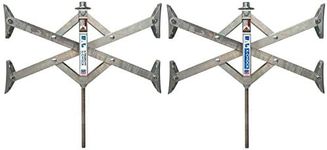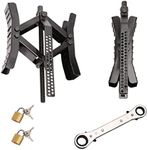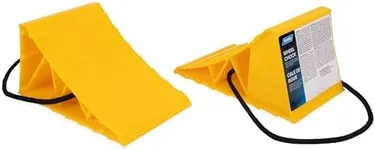Buying Guide for the Best Rv Wheel Chocks
Choosing the right RV wheel chocks is essential for ensuring your vehicle stays securely in place when parked. Wheel chocks prevent accidental rolling, providing safety and peace of mind whether you're on a slope or a flat surface. When shopping for wheel chocks, it's important to consider the size, material, grip, and ease of use to match your RV and your typical parking situations. Understanding the key specifications will help you select chocks that are both effective and convenient for your needs.MaterialThe material of RV wheel chocks determines their durability, weight, and grip. Common materials include rubber, plastic, and metal. Rubber chocks are known for their excellent grip and resistance to slipping, making them ideal for most surfaces. Plastic chocks are lightweight and easy to handle, but may not be as durable or grippy on slick surfaces. Metal chocks are very strong and durable, suitable for heavy-duty use, but can be heavier and may require more effort to position. When choosing, consider where you'll be parking most often and how much weight your chocks need to support.
Size and Weight CapacityThe size and weight capacity of wheel chocks are crucial for ensuring they can handle your RV's weight and tire size. Chocks come in various sizes, with larger chocks providing more surface area and stability for bigger vehicles. Weight capacity refers to how much load the chock can safely hold without slipping or breaking. For small trailers or lightweight RVs, smaller chocks may suffice, while larger motorhomes require bigger, sturdier chocks. Always check your RV's weight and tire dimensions, and choose chocks that are rated to handle more than your vehicle's weight for added safety.
Grip and Surface DesignGrip refers to how well the chock stays in place on different surfaces, such as gravel, asphalt, or grass. Some chocks have textured or ribbed surfaces to increase friction and prevent slipping, while others may have smooth surfaces that are less effective on slick ground. The bottom design can also affect how well the chock grips the ground. If you often park on uneven or slippery surfaces, look for chocks with aggressive tread patterns or rubberized bases for maximum stability.
Ease of Use and PortabilityEase of use covers how simple it is to position, remove, and store the chocks. Lightweight chocks are easier to carry and set up, but may not be as stable as heavier ones. Some chocks come with handles or ropes for easy placement and removal, which can be especially helpful if you have limited mobility or need to set up quickly. Portability is important if you move your RV frequently or have limited storage space. Consider how often you'll be using the chocks and whether features like handles or stackable designs would make your experience more convenient.
Weather ResistanceWeather resistance refers to how well the chocks hold up against sun, rain, and temperature changes. Chocks that are UV-resistant won't crack or degrade as quickly in sunlight, while those that resist water won't become slippery or lose strength when wet. If you camp in a variety of climates, look for chocks specifically designed to withstand harsh weather conditions. This ensures your chocks remain reliable and safe over time, no matter where your travels take you.














